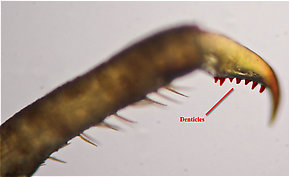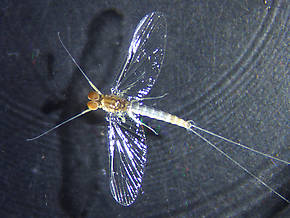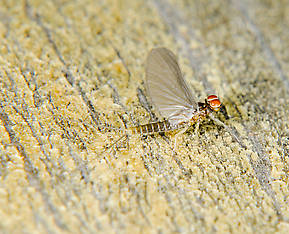Blog & Latest Updates
Fly Fishing Articles
Insects by Common Name


Light Rusty Spinners
Scientific Names
| Match | Scientific Name |
| Baetis bicaudatus | |
| Baetis tricaudatus |
Like most common names, "Light Rusty Spinner" can refer to more than one taxon. They're previewed below, along with 5 specimens. For more detail click through to the scientific names.
Mayfly Species Baetis bicaudatus
These are very rarely called Light Rusty Spinners.
Baetis bicaudatus is a western taxon of some local importance.
Baetis bicaudatus (BWO) Mayfly Nymph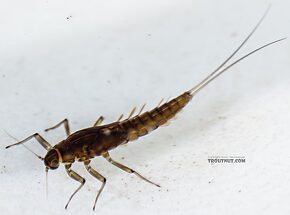 View 5 PicturesHere I'm just copying and pasting, without cleaning up, my notes from spending a long time with this one under the microscope (and keying with Merritt & Cummins 5th Ed) only to end up confirming the most likely guess.
View 5 PicturesHere I'm just copying and pasting, without cleaning up, my notes from spending a long time with this one under the microscope (and keying with Merritt & Cummins 5th Ed) only to end up confirming the most likely guess.
7. Baetis bicaudatus nymph
1. Hind wingpad present but small and hidden beneath forewing pad
2. Segment 2 of labial palp (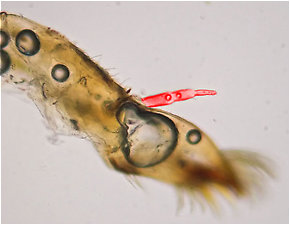 Palp: A long, thin, often segmented appendage which can protrude from certain insect mouth parts such as the maxillae. Also known as the < />palpus.) with well-developed medially projecting corner —> Baetis (couple 44)…. BUT no sign of scale-like setae (Seta: Little hairs on insects.) on abdominal terga (Tergum: the dorsal part of an abdominal segment or segments (terga). Also used to describe the entire abdominal dorsum or the thoracic dorsal segments of Odonata.). Conflicts at this couplet.
Palp: A long, thin, often segmented appendage which can protrude from certain insect mouth parts such as the maxillae. Also known as the < />palpus.) with well-developed medially projecting corner —> Baetis (couple 44)…. BUT no sign of scale-like setae (Seta: Little hairs on insects.) on abdominal terga (Tergum: the dorsal part of an abdominal segment or segments (terga). Also used to describe the entire abdominal dorsum or the thoracic dorsal segments of Odonata.). Conflicts at this couplet.
3. Gills on segments I-VII
4. Tarsal claws (Tarsal claw: The claws at the tip of the tarsus, on an insect's "foot.") with denticles (Denticle: Small tooth-like projects, often appearing like serrations on the tarsal claws of certain mayfly nymphs.), seemingly 2 rows but very hard to tell… and the key options with 2 rows don’t make sense
5. Assuming no villipore, we land confidently at couplet 48
6. Leads to Fallceon, except antennal scape doesn’t have robust setae (Seta: Little hairs on insects.)
7. Treated as Baetis, leads to brunneicolor, but McDunnough et al 1932 (Can Ent 64) suggests middle tail should be 5/6 as long as outer ones
8. Keys VERY confidently to couplet 36 in M&C (villipore)
9. If assuming villipore present:
1. 37 —> Scape of anntenae has no distal (Distal: Far from the point of attachment or origin; near the tip.) lobe —> rules out Labiobaetis (100 % certain)
2. 38 —> Terminal filament much shorter than cerci (Cercus: The left and right "tails" of an insect are known as the cerci or caudal cerci. The middle tail of a three-tailed insect is not.) —> not Barbaetis benfieldi (100 % certain)
3. 39 —> Terminal filament reduced (100 % certain)
4. 40 —> Tarsal claw (Tarsal claw: The claws at the tip of the tarsus, on an insect's "foot.") dentical count couplet. If two rows of denticles (Denticle: Small tooth-like projects, often appearing like serrations on the tarsal claws of certain mayfly nymphs.): Either Iswaeon or Heterocloeon. Can’t be Iswaeon because cerci (Cercus: The left and right "tails" of an insect are known as the cerci or caudal cerci. The middle tail of a three-tailed insect is not.) lack dark median band. Can’t be heterocloeon because it’s not in the Platte drainage or in Texas. Thus, it must be one row of denticles (Denticle: Small tooth-like projects, often appearing like serrations on the tarsal claws of certain mayfly nymphs.). Moving on to 42.
5. 42 —> Hind wing pads (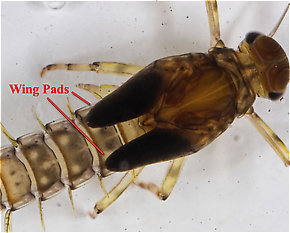 Wing pad: A protrusion from the thorax of an insect nymph which holds the developing wings. Black wing pads usually indicate that the nymph is nearly ready to emerge into an adult.) present (100 % certain)
Wing pad: A protrusion from the thorax of an insect nymph which holds the developing wings. Black wing pads usually indicate that the nymph is nearly ready to emerge into an adult.) present (100 % certain)
6. 44 —> Segment 2 of labial palpi with well-developed medially projecting corner (80 % certain), scale-like setae (Seta: Little hairs on insects.) not evident on terga (Tergum: the dorsal part of an abdominal segment or segments (terga). Also used to describe the entire abdominal dorsum or the thoracic dorsal segments of Odonata.) but maybe limitation of my scope —> Baetis (alternative would be Acentrella, but pronotum (Pronotum: The top of the insect prothorax.) shape is all wrong for those, although not an official characteristic)
7. CONFIDENT in Baetis bicaudatus after distinctive leg markings (J-shaped light mark on first femur (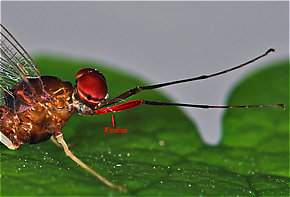 Femur: The main segment of an insect's leg close to the body, in between the tibia and the trochanter.), L-shaped on second and third) matches original species description to a tee.
Femur: The main segment of an insect's leg close to the body, in between the tibia and the trochanter.), L-shaped on second and third) matches original species description to a tee.
 View 5 PicturesHere I'm just copying and pasting, without cleaning up, my notes from spending a long time with this one under the microscope (and keying with Merritt & Cummins 5th Ed) only to end up confirming the most likely guess.
View 5 PicturesHere I'm just copying and pasting, without cleaning up, my notes from spending a long time with this one under the microscope (and keying with Merritt & Cummins 5th Ed) only to end up confirming the most likely guess.7. Baetis bicaudatus nymph
1. Hind wingpad present but small and hidden beneath forewing pad
2. Segment 2 of labial palp (

The palp on the maxilla of an Ephemerella nymph (detached and photographed under a microscope) is highlighted in red here.
3. Gills on segments I-VII
4. Tarsal claws (Tarsal claw: The claws at the tip of the tarsus, on an insect's "foot.") with denticles (Denticle: Small tooth-like projects, often appearing like serrations on the tarsal claws of certain mayfly nymphs.), seemingly 2 rows but very hard to tell… and the key options with 2 rows don’t make sense
5. Assuming no villipore, we land confidently at couplet 48
6. Leads to Fallceon, except antennal scape doesn’t have robust setae (Seta: Little hairs on insects.)
7. Treated as Baetis, leads to brunneicolor, but McDunnough et al 1932 (Can Ent 64) suggests middle tail should be 5/6 as long as outer ones
8. Keys VERY confidently to couplet 36 in M&C (villipore)
9. If assuming villipore present:
1. 37 —> Scape of anntenae has no distal (Distal: Far from the point of attachment or origin; near the tip.) lobe —> rules out Labiobaetis (100 % certain)
2. 38 —> Terminal filament much shorter than cerci (Cercus: The left and right "tails" of an insect are known as the cerci or caudal cerci. The middle tail of a three-tailed insect is not.) —> not Barbaetis benfieldi (100 % certain)
3. 39 —> Terminal filament reduced (100 % certain)
4. 40 —> Tarsal claw (Tarsal claw: The claws at the tip of the tarsus, on an insect's "foot.") dentical count couplet. If two rows of denticles (Denticle: Small tooth-like projects, often appearing like serrations on the tarsal claws of certain mayfly nymphs.): Either Iswaeon or Heterocloeon. Can’t be Iswaeon because cerci (Cercus: The left and right "tails" of an insect are known as the cerci or caudal cerci. The middle tail of a three-tailed insect is not.) lack dark median band. Can’t be heterocloeon because it’s not in the Platte drainage or in Texas. Thus, it must be one row of denticles (Denticle: Small tooth-like projects, often appearing like serrations on the tarsal claws of certain mayfly nymphs.). Moving on to 42.
5. 42 —> Hind wing pads (

The wing pads on this final instar Baetidae mayfly nymph are extremely dark.
6. 44 —> Segment 2 of labial palpi with well-developed medially projecting corner (80 % certain), scale-like setae (Seta: Little hairs on insects.) not evident on terga (Tergum: the dorsal part of an abdominal segment or segments (terga). Also used to describe the entire abdominal dorsum or the thoracic dorsal segments of Odonata.) but maybe limitation of my scope —> Baetis (alternative would be Acentrella, but pronotum (Pronotum: The top of the insect prothorax.) shape is all wrong for those, although not an official characteristic)
7. CONFIDENT in Baetis bicaudatus after distinctive leg markings (J-shaped light mark on first femur (

The femur of this Isonychia bicolor mayfly spinner is highlighted in red.
See 2 more specimens...
Mayfly Species Baetis tricaudatus
These are very rarely called Light Rusty Spinners.
Baetis tricaudatus is undeniably the most widespread and abundant baetid on the continent and arguably the most important mayfly species to trout and anglers alike. Eastern anglers used to know these important mayflies by the storied name of Baetis vagans. Conversely, the usually much larger and late Fall hatching brood of Baetis tricaudatus was considered an important Western species with its own tradition. But, entomologists recently determined that they are both in fact the same species. The nomenclature conventions guiding entomologists do not account for a name's regional fame among fishermen, and new or obscure species names may replace their old favorites. Sometimes taxa with disparate traditions are combined. Baetis vagans is one such casualty. Fortunately, trout think like Shakespeare: A rose by any other name would smell as sweet. The rose that was vagans has lost none of its charm. This species is multibrooded (Multibrooded: Producing more than one generation in a single year. Baetis mayflies are a classic example. Insects which produce a single generation with two distinct peaks (like the June and September hatches of Isonychia bicolor mayflies) are not multibrooded, because the fall insects are offspring from the previous fall instead of the current year's spring.) with the hatches of Spring being larger flies. As the weather warms the following broods are composed of progressively smaller flies. In the East, they range in size from 16 to 20. In the West, they may run a size larger.
Male Baetis tricaudatus (Blue-Winged Olive) Mayfly Nymph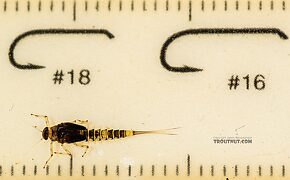 View 14 PicturesThis specimen and many like it were found with other specimens I found to be duller-colored females of the same species. I wasn't aware of such a difference between male and female nymphs in Baetids, but all the morphological characteristics I checked in the key were the same, and the color patterns are, too -- just not the brightness.
View 14 PicturesThis specimen and many like it were found with other specimens I found to be duller-colored females of the same species. I wasn't aware of such a difference between male and female nymphs in Baetids, but all the morphological characteristics I checked in the key were the same, and the color patterns are, too -- just not the brightness.
 View 14 PicturesThis specimen and many like it were found with other specimens I found to be duller-colored females of the same species. I wasn't aware of such a difference between male and female nymphs in Baetids, but all the morphological characteristics I checked in the key were the same, and the color patterns are, too -- just not the brightness.
View 14 PicturesThis specimen and many like it were found with other specimens I found to be duller-colored females of the same species. I wasn't aware of such a difference between male and female nymphs in Baetids, but all the morphological characteristics I checked in the key were the same, and the color patterns are, too -- just not the brightness.Male Baetis tricaudatus (Blue-Winged Olive) Mayfly Dun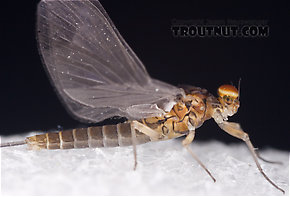 View 8 PicturesThis male was associated with a female of the same species.
View 8 PicturesThis male was associated with a female of the same species.
 View 8 PicturesThis male was associated with a female of the same species.
View 8 PicturesThis male was associated with a female of the same species.See 8 more specimens...
Top 10 Fly Hatches
Top Gift Shop Designs
Eat mayflies.
Top Insect Specimens
Miscellaneous Sites
Troutnut.com is copyright © 2004-2024 Jason
Neuswanger (email Jason). See my FAQ for information about use of my images.
 privacy policy
privacy policy

